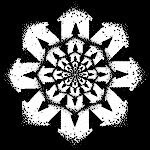 I am working on writing up my ideas about chaos theory as applied to religion and, while it was easy for me to point out the role of uncertainty and the danger of faith in science, it pains me to put into words what seems antithetical to religion: that there is no absolute truth to be had.
I am working on writing up my ideas about chaos theory as applied to religion and, while it was easy for me to point out the role of uncertainty and the danger of faith in science, it pains me to put into words what seems antithetical to religion: that there is no absolute truth to be had.I may be a bit more sensitive to the feelings of the faithful than your average atheist, but I would still never recommend that anyone should actually adhere to someone else's religion. Make one up for yourself maybe, and never take it too seriously, but don't ever buy one of those off the shelf models. Here's why:
One of the aesthetics suggested by chaos theory is the property of fractals to display self similarity at different scales, as demonstrated by zooming in on the mini-Mandelbrots in the Mandelbrot set.
Another is their fractional dimensionality. Unlike euclidean geometrical shapes fractals have borders of infinite complexity which interpenetrate their surroundings.
 Applied to nature, these concepts are much more useful than linear measures for understanding phenomenon like clouds and turbulence. It is easy for casual observer to see the similarity of clouds or ripples of different sizes, or at various distances and magnifications. As well, anyone can see the lack of real borders between the clouds and the air, or between a whirlpool and the water.
Applied to nature, these concepts are much more useful than linear measures for understanding phenomenon like clouds and turbulence. It is easy for casual observer to see the similarity of clouds or ripples of different sizes, or at various distances and magnifications. As well, anyone can see the lack of real borders between the clouds and the air, or between a whirlpool and the water.If we look at human existence in this way, we will see that humans (and other living things) are also like this. Since we shed all our cellular material over a seven year period and new material is absorbed from our surroundings through the convoluted interfaces of our skin, lungs and digestive systems; we are more like a vortex moving through a medium than we are like a solid object. We dissipate through time; chances are you are occupying an entirely different physical body than the one you originally used to log onto the Internet that very first time, all those years ago, yet somehow there is a continuity of consciousness even though you think and feel different.
As such, we are similar to and yet different from each other, from our former "selves" and from our ancestors and evolutionary predecessors. The physical borders between our "selves" and the environment are indistinct, permeable and variable.
I have digressed, but my point is that I would like to apply these ways of looking at things to the subject of religion. The clip below demonstrates the property of self similarity in religion. We can see that figures such as Jesus and Moses are not unique occurrences in time but reiterations of a historical formula. And so truth in religion can not be absolute, but will tend to recur, self-similarly (like a self-fulfilling prophesy), in myths, social and family structures, and personal development - right down to WWJD (what would Jesus do) today.
I highly recommend you watch the whole movie. Zeitgeist is available in 13 parts on YouTube. I definitely want to write more about it here, as the producers present some thought provoking ideas about the social structures used to control the masses and promote the New World Order.


1 comment:
I'd like to add an additional interpretation to the one given in the Zeitgeist clip. They say that December 25 astrologically represents the death of the Sun, but it isn't clear why this is also the Birth of the Sun God.
My interpretation, which is derived from Tom Harpur's "The Pagan Christ", is that December 25 is more appropriately seen as the "incarnation" of The Sun into the flesh.
For the gnostic, when the sun goes down into the earth this symbolizes life as the "long dark night of the soul".
Christ only returns to his native form, Light, in the spring when the sun returns to the northern hemisphere.
The cross also represents the intersection of spirit/energy (the vertical line) with material/flesh (the horizontal line, "line of Horus?").
These two opposing views of the Sun/Son of God, are a mirror symmetry: death is life and life is death.
Post a Comment